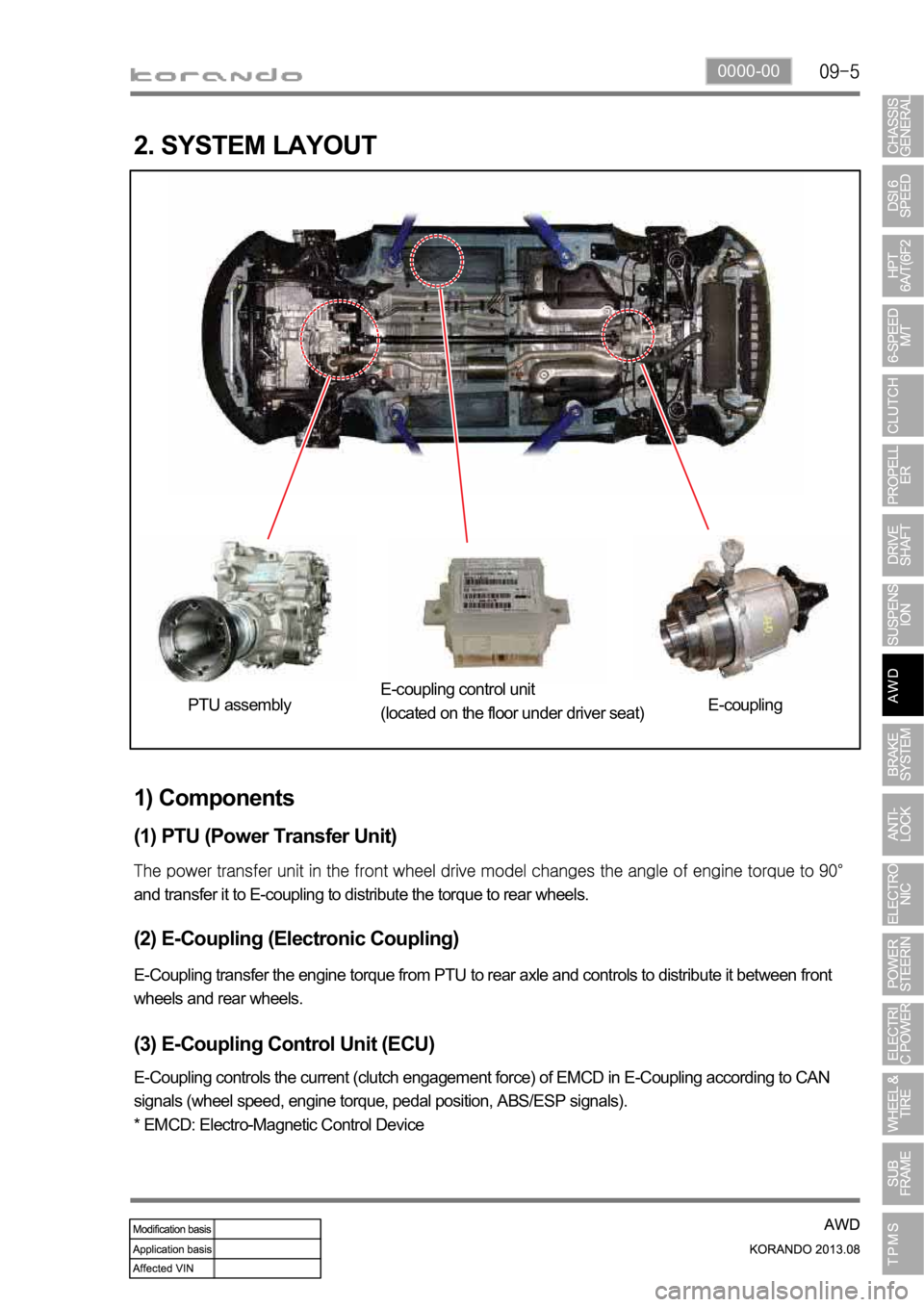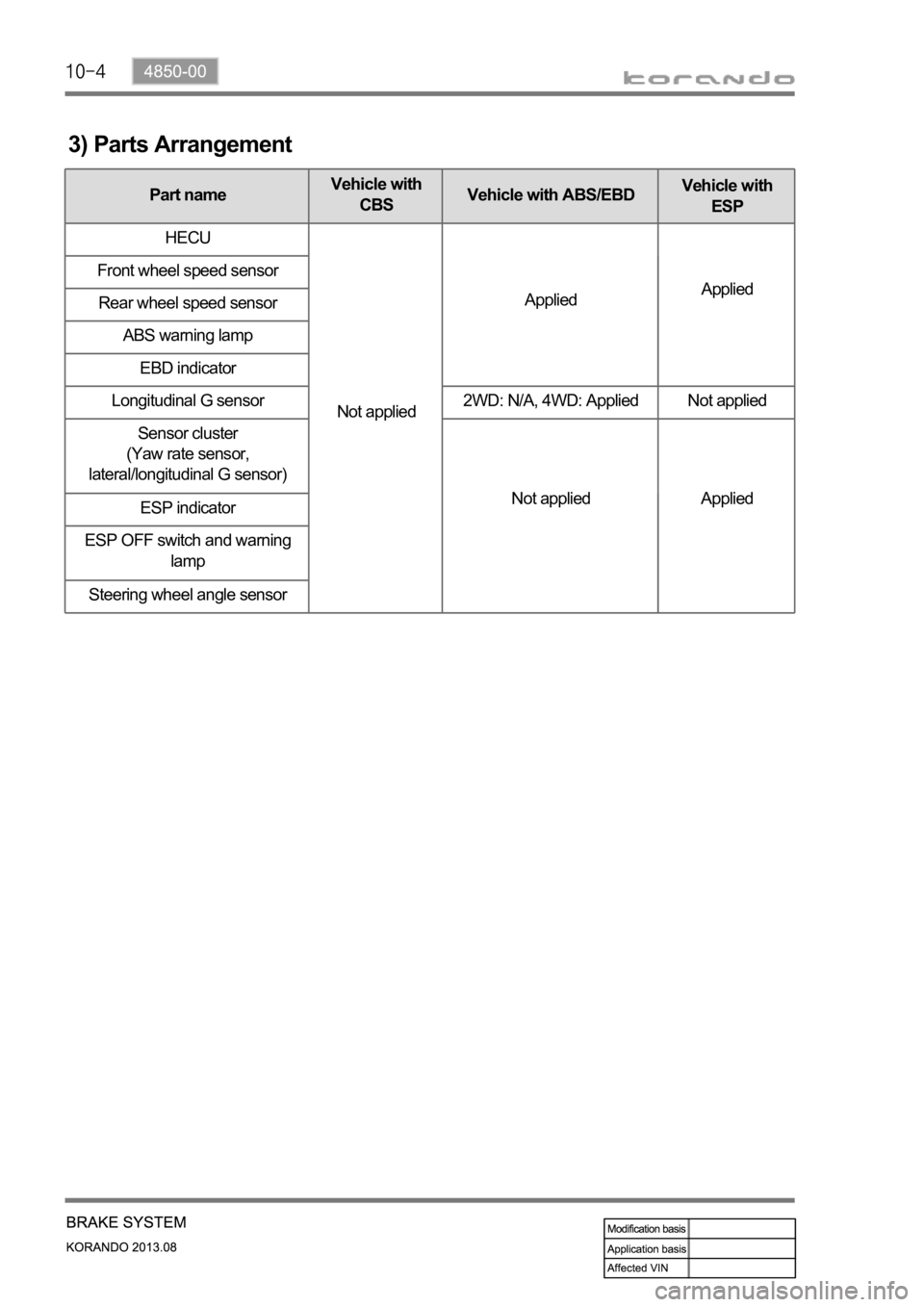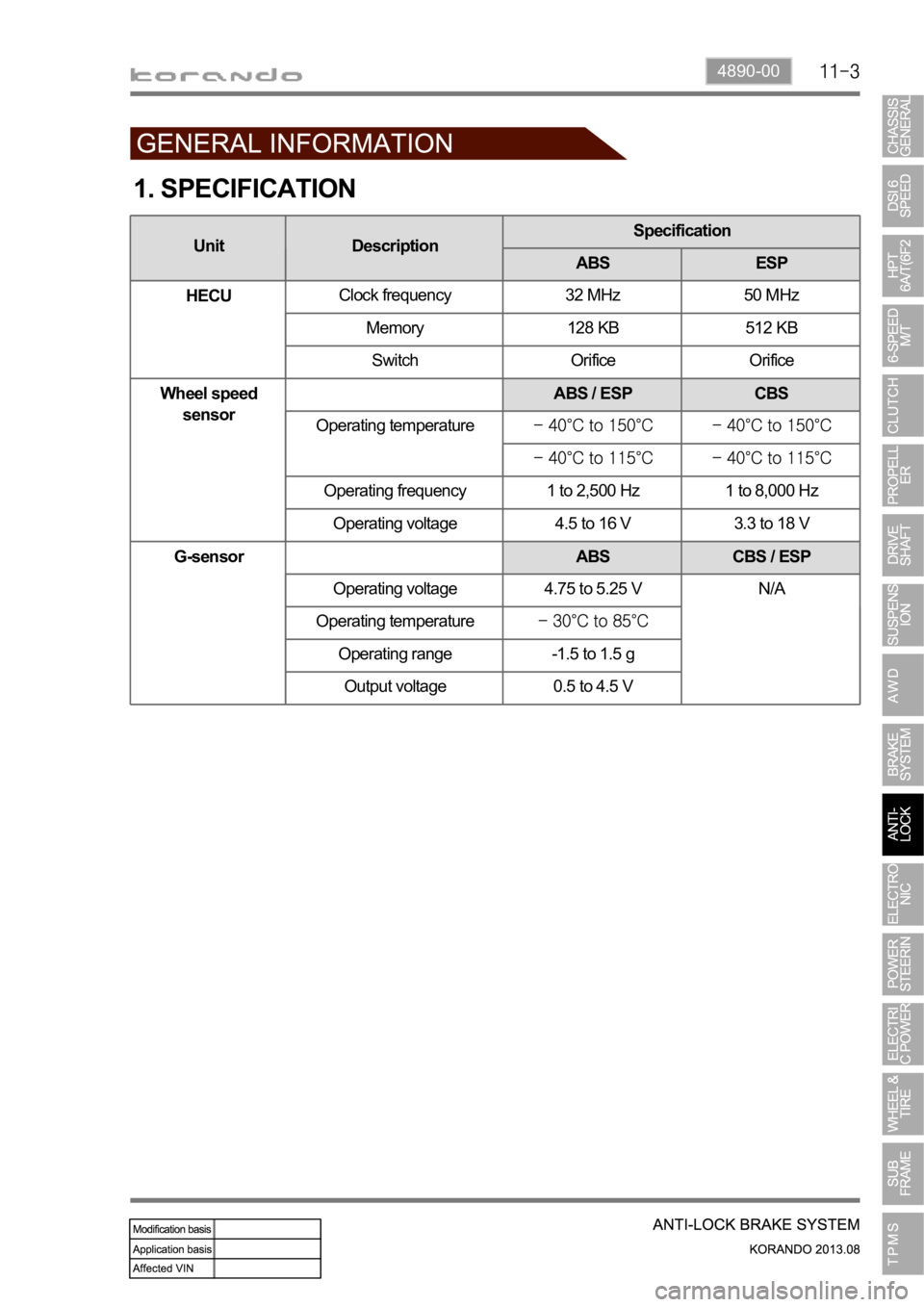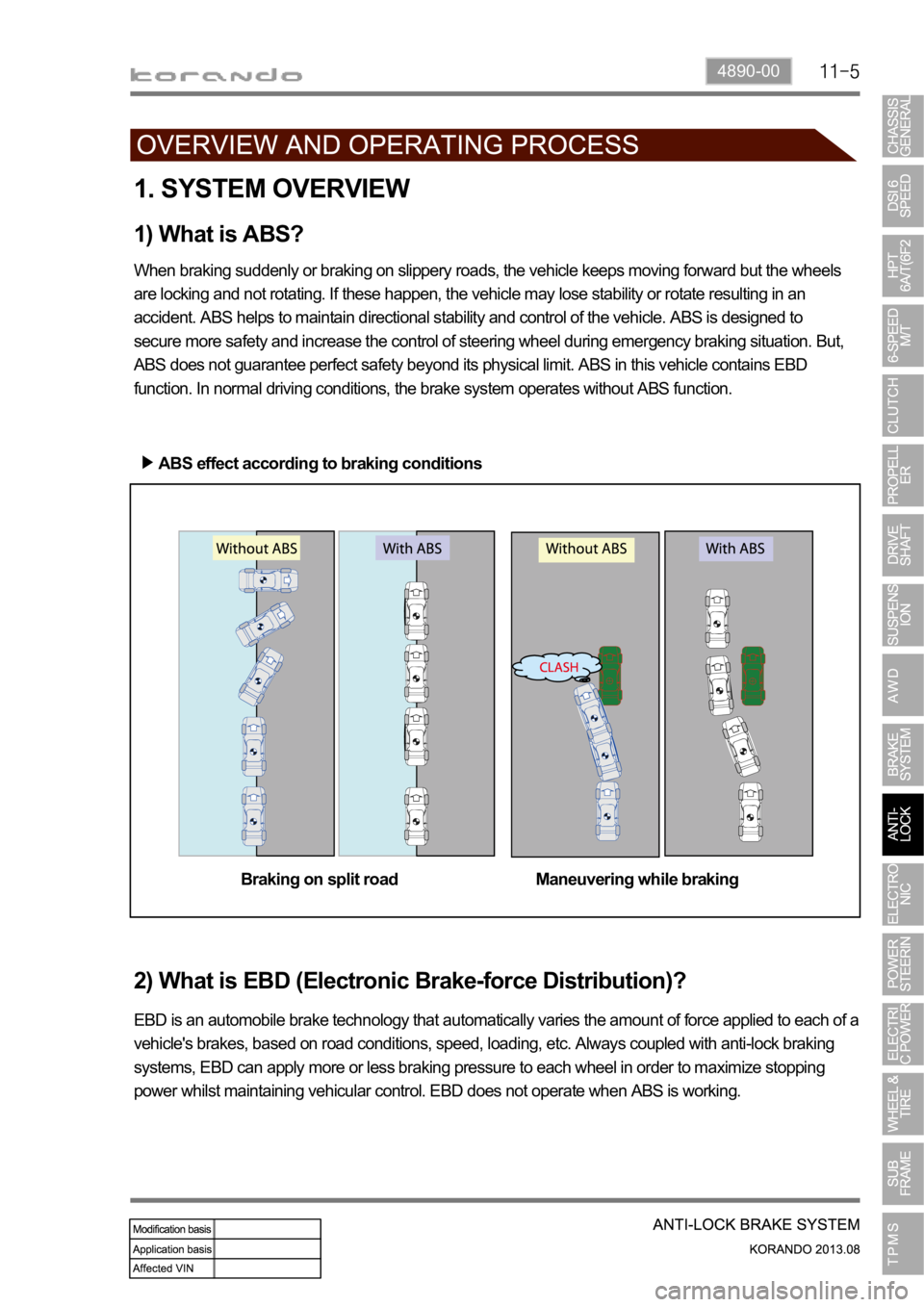ECU SSANGYONG KORANDO 2013 Service Manual
[x] Cancel search | Manufacturer: SSANGYONG, Model Year: 2013, Model line: KORANDO, Model: SSANGYONG KORANDO 2013Pages: 1336, PDF Size: 92.18 MB
Page 1087 of 1336

0000-00
2. SYSTEM LAYOUT
1) Components
(1) PTU (Power Transfer Unit)
and transfer it to E-coupling to distribute the torque to rear wheels.
(2) E-Coupling (Electronic Coupling)
E-Coupling transfer the engine torque from PTU to rear axle and controls to distribute it between front
wheels and rear wheels.
(3) E-Coupling Control Unit (ECU)
E-Coupling controls the current (clutch engagement force) of EMCD in E-Coupling according to CAN
signals (wheel speed, engine torque, pedal position, ABS/ESP signals).
* EMCD: Electro-Magnetic Control Device PTU assemblyE-coupling control unit
(located on the floor under driver seat)E-coupling
Page 1089 of 1336

3) Parts Arrangement
Part nameVehicle with
CBSVehicle with ABS/EBDVehicle with
ESP
HECU
Not appliedAppliedApplied Front wheel speed sensor
Rear wheel speed sensor
ABS warning lamp
EBD indicator
Longitudinal G sensor 2WD: N/A, 4WD: Applied Not applied
Sensor cluster
(Yaw rate sensor,
lateral/longitudinal G sensor)
Not applied Applied
ESP indicator
ESP OFF switch and warning
lamp
Steering wheel angle sensor
Page 1090 of 1336

4850-00
A. Meter cluster-ABS, EBD, ESP
indicator/warning lampB. Master cylinder and
boosterC. HECU
F. Front/rear wheel speed sensor
Front/rear-4WD Rear-2WDH. Parking brakeG. Brake pedal
4) Component
ABS warning lamp
ESP indicator
D. Front brake
assembly
E. Rear brake
assembly
Disc
Disc
Parking brake
warning lamp
Caliper
Caliper
Page 1095 of 1336

3. SYSTEM LAYOUT
Hydraulic line
Brake booster
Brake reservoir and master cylinder
Front disc brake and caliper 1.
2.
3.HECU (Hydraulic & Electric Control Unit)
Rear disc brake and caliper 4.
5.
Page 1099 of 1336

4890-00
1. SPECIFICATION
Unit DescriptionSpecification
ABS ESP
HECUClock frequency 32 MHz 50 MHz
Memory 128 KB 512 KB
Switch Orifice Orifice
Wheel speed
sensorABS / ESP CBS
Operating temperature
Operating frequency 1 to 2,500 Hz 1 to 8,000 Hz
Operating voltage 4.5 to 16 V 3.3 to 18 V
G-sensor ABS CBS / ESP
Operating voltage 4.75 to 5.25 V N/A
Operating temperature
Operating range -1.5 to 1.5 g
Output voltage 0.5 to 4.5 V
Page 1101 of 1336

4890-00
1. SYSTEM OVERVIEW
1) What is ABS?
When braking suddenly or braking on slippery roads, the vehicle keeps moving forward but the wheels
are locking and not rotating. If these happen, the vehicle may lose stability or rotate resulting in an
accident. ABS helps to maintain directional stability and control of the vehicle. ABS is designed to
secure more safety and increase the control of steering wheel during emergency braking situation. But,
ABS does not guarantee perfect safety beyond its physical limit. ABS in this vehicle contains EBD
function. In normal driving conditions, the brake system operates without ABS function.
2) What is EBD (Electronic Brake-force Distribution)?
EBD is an automobile brake technology that automatically varies the amount of force applied to each of a
vehicle's brakes, based on road conditions, speed, loading, etc. Always coupled with anti-lock braking
systems, EBD can apply more or less braking pressure to each wheel in order to maximize stopping
power whilst maintaining vehicular control. EBD does not operate when ABS is working. ABS effect according to braking conditions
Braking on split road Maneuvering while braking
Page 1103 of 1336

4890-00
4WD - Front/Rear wheel speed
sensor
2WD - Front wheel speed sensor
2WD - Rear wheel speed sensor
ECU (Electronic Control Unit) 1.
ECU calculates the wheel speed, acceleration and
deceleration with the information from wheel
speed sensor, and determines the wheel slip to
control the valve and motor.
HU (Hydraulic Unit) 2.
The hydraulic circuit contains the primary circuit
and secondary circuit for ABS operation. This unit
controls the hydraulic pressure to each wheel. If
the system needs ABS operation, the valves in
the unit operate to control HOLD, RISE and
DUMP according to ECU control logic.
Motor 3.
The motor is operated when ABS is activated. The
cam-shaped output shaft of the motor enables the
brake system to receive and supply the brake fluid
during the motor operation.
Wheel speed sensor
Wheel speed sensor sends the data detected by
tone wheel to HECU.
HECU
Rear wheel speed sensor in 2WD vehicle is
different from that in 4WD vehicle.
Location of rear tone wheel (A) and wheel
sensor (B) in 2WD vehicle
Page 1104 of 1336

G-sensor (only for 4WD)
For the vehicle with the ABS, a speed difference
between the wheels is not noticeable as all the
wheels are slipping during abrupt braking.
Therefore, the vehicle needs the speed
information from other sensors other than the
wheel speed sensor. On the 2WD vehicle, there
is not large difference between the vehicle speed
reduction and actual wheel speed reduction in
the event of braking since the driving wheels are
in the front. So, the ABS HECU can control the
vehicle, based on a calculation value. But, on the
4WD vehicle, if a speed reduction occurs in the
front or rear of the vehicle, it affects the other side
wheel. In other words, braking the rear wheels
induces also a large speed reduction in the front
wheels. The longitudinal acceleration sensor is
used for this case. It controls the ABS by using
the signals from the sensor during abrupt braking
and acceleration.
G-sensor
Page 1106 of 1336

4. WARNING LAMPS
1) ABS Warning Lamp
ABS warning lamp module indicates the self diagnosis and malfunction.
ABS warning lamp ON:
When turning the ignition switch to ON position, ABS warning lamp comes on for 3 seconds for self-
diagnosis and goes off if the system is OK (initialization mode).
When the system is defective, the warning lamp comes on.
When the self-diagnosis is performing, the warning lamp comes on.
When the HECU connector is disconnected, the warning lamp comes on.
ABS is not available during lamp ON. In this condition, Only normal brake system without ABS function
is available.
When the communication between warning lamp CAN module in meter cluster, the warning lamp
comes on. 1.
2.
3.
4.
5.
6.
ABS warning lamp
Brake warning lamp
(EBD warning lamp: ABS warning lamp + Brake warning lamp) 1.
2.
Page 1107 of 1336

4890-00
2) EBD (Electronic Brake-force Distribution) Warning Lamp (Brake
Warning Lamp)
EBD warning lamp when the system performs the self diagnosis and when it detects the malfunction of
EBD system. However, the brake warning lamp comes on regardless of EBD when the parking brake is
applied.
EBD warning lamp ON:
When turning the ignition switch to ON position, ABS warning lamp and the brake warning lamp
comes on for 3 seconds for self diagnosis and goes off if the system is OK (initialization mode).
When applying the parking brake, the brake warning lamp comes on.
When the brake fluid is not sufficient, the brake warning lamp comes on.
When the self-diagnosis is performing, the warning lamp comes on.
When the HECU connector is disconnected, the warning lamp comes on.
When the system is defective, ABS warning lamp and the brake warning lamp come on
simultaneously. 1.
2.
3.
4.
5.
6.
When the solenoid valve is defective
When one or more wheel sensors are defective
When ABS HECU is defective
When the voltage is abnormal
When valve relay is defective a.
b.
c.
d.
e.
When the communication between warning lamp CAN module in meter cluster, the warning lamp
comes on. 7.